Another day brings another blogathon and this time, it’s all about the music of Star Trek and is hosted by Becky over at Film Music Central. Thanks for hosting; I’m certainly anxious to throw my hat into this particular ring, being a dedicated Star Trek fan and as always, I’m interested in seeing what everyone else will come up with.
There is certainly lots to talk about when it comes to the music of Trek films but there is a certain episode from the original TV series with a memorable score that has found its way into the heart of popular culture. Even if you haven’t seen the episode, it’s likely that you’ll recognize the pivotal piece of music that is found in this episode.
“Amok Time” is the premiere episode of the second original series, written by Theodore Surgeon and directed by Joseph Pevney. Leonard Nimoy has highly praised it, approving of its “excellent script” and calling the episode “poetic, very dramatic, intense and important”; it is indeed an important episode, since it was the first one to properly explore Vulcan ways and customs. The episode is famous for having the “Kirk vs. Spock” fight-to-the-death and as mentioned before, the accompanying piece of music is certainly recognisable and subsequently featured in later Trek episodes, more or less becoming its standard “fight music”
Plot
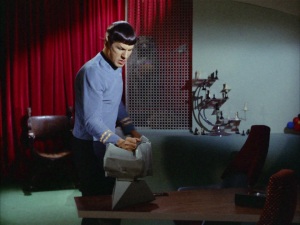
When the Enterprise’s first officer Spock starts acting irrationally with strange, violent outbursts, he requests to be taken to his home planet of Vulcan for reasons that he claims are deeply private and personal. It is later revealed that it is the Pon Farr, the Vulcan time of mating that each Vulcan must go through every seven years, or else their pent up physical and emotional pressures will kill them.
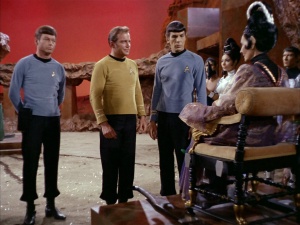
Ultimately, having to disobey Starfleet orders in the process, Kirk takes Spock down to Vulcan, with Doctor McCoy in tow, where Spock begins the Koon-at-kal-if-fee, meaning “marriage or challenge”. However, his bride-to-be T’Pring rejects Spock, choosing Kirk instead . This means that Spock is forced into a “to the death” duel with Kirk.

Eventually, it appears that Kirk dies during the duel, which satisfies Spock’s blood fever and in turn, he turns T’Pring down, though it ultimately transpires that she did not want Spock at all, preferring the Vulcan Stonn instead. She chose to challenge because, regardless of the outcome, she would end up with Stonn in the end.
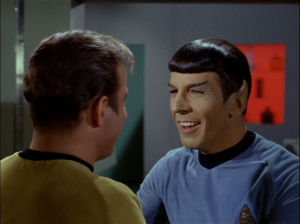
Back on the Enterprise, Spock sees that Kirk is actually alive, since during the battle, McCoy injected Kirk with a neural paralyzer that simulated death, allowing Spock to overcome his blood fever and end the ritual. All of which leads to a rare smile from Spock and very nearly results in, as McCoy puts it, “an emotional display that would have brought the house down”!
Music Throughout the Episode
Obviously the fight scene music will be the main focus of this post but in watching the episode, I realised that there is indeed great music to be found throughout the episode so let’s go through some memorable moments.
- In early scenes, there is a skillful use of low, twanging guitar strings and a woodwind dirge that signifies Spock’s decreasing mental state, especially noticeable when it seems as though Spock is on the verge of stabbing Kirk with a sharp object hidden behind his back.
- When Spock begins explaining the Pon Farr, a steady, rhythmic beat, primarily featuring woodwind and tambourines, is introduced and it comes to a gentle stop when he finishes speaking. This prepares us for the later ritual scene on Vulcan and it conveys a sense of ceremony and ritual.
- Spock is briefly seen playing his lute, which was seen numerous times during the series, perhaps most prominently in the episode “Charlie X”.
- When Kirk decides to disobey orders and help Spock, the music is bold, heroic and uplifting, rallying the audience and reinforcing the idea of putting friends before all else.
- In an intimite scene featuring Spock and Nurse Chapel, strings are used to convey a tender, melancholy feel.
- When T’Pau, T’Pring, Stonn and the rest of the Vulcan procession are introduced, as in the earlier scene, the music is a steady, rhythmic beat featuring tambourines and woodwind; the production team wanted to give the Vulcan ceremony a certain Middle Eastern/Japanese vibe and that is apparent here.
The Fight
Accompanying the pivotal fight scene is the piece entitled “The Ritual/Ancient Battle”. It was composed by Gerald Fried and has been described as:
“a model of action scene bombast, wildly percussive and bursting with exclamatory trumpet, flute and woodwind trills to accentuate the hammering of the brass performed fanfare” (from “The Music of Star Trek” by Jeff Bond)
Hmmm, I guess that just about says it all, I’m not sure what else I can even add!
Seriously though, music is indeed used very effectively in this particular section; from the moment when T’Pring chooses to challenge, the music is slowly built up, the rhythmic percussion gains momentum and eventually, the music is almost a relentless shrieking. Combined with dizzying camerawork, it successfully increases the tension and ensures that the following fight is as exciting and dramatic as possible.
“The Ritual/Ancient Battle” is relentless, rhythmic, dramatic and, even if you’re just listening to the music on its own, perfectly conjures up images of gladiators fighting in an arena. It successfully fits with what is happening on screen and it is clear as to why this piece was reused in later episodes.
Interesting Episode Facts
- “Amok Time” marks the first time that “Live Long and Prosper” is said.
- It also features the first appearance of the Vulcan hand salute. Leonard Nimoy came up with it: when he was a child, during a high holiday synagogue service, he witnessed a Rabbi make the gesture (even though Nimoy was actually supposed to be respectfully covering his eyes at the time). It was the Hebrew letter “shin”, which means “Almighty”
- Even though this episode is primarily concerned with biology and mating, it surprisingly gathered little criticism from the public. However, German TV station ZDF did cut a few scenes and rewrote dialogue, claiming that Spock was actually suffering from “Weltraumfieber” or “Space Fever”
- Rather than spend a generous amount of money applying prosthetic ears to all the Vulcan extras, their ears were covered up with helmets recycled from “Balance of Terror”
In Popular Culture
“Amok Time”‘s fight music is certainly recognisable and chances are, you’ve heard it in various films and TV shows:
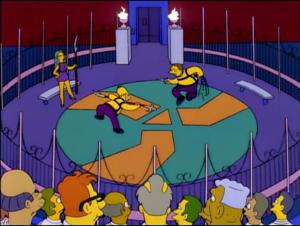
In the Simpsons episode “Deep Space Homer”, as part of their NASA training, Homer and Barney are briefly seen competing in a similar to-the-death fight, with the fight music being played overhead. A NASA technician wagers “400 quatloos on the newcomer” (this is actually based more on the episode ” The Gamesters of Triskelion”)
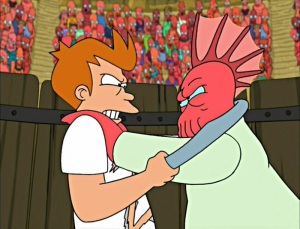
The music also appears in the Futurama episode “Why Must I be a Crustacean in Love?”; Fry finds himself forced into a deadly battle of Claw-Plach, a similar “marriage or challenge” scenario. Before the battle, the fight music is played as the planet’s national anthem and Fry, being a huge Trek fan, immediately recognises that things won’t end well . . .
And perhaps most popular of all is its use in The Cable Guy; while at Medieval Times resteraunt, Steve (Matthew Broderick) is thrust into the gladitorial arena to do battle against the unhinged Chip Douglas (Jim Carrey). A TV addict, Chip immediately compares it all to “that time when Spock had to fight Kirk on Star Trek!” He then proceeds to “sing” the fight song and has a blast impersonating Leonard Nimoy; “Goodbye, Jim!”
“The Cable Guy” Medieval Times Fight Scene
Of course, all of this goes to show how effective and exciting the music is and how it can transcend genre and be instantly recognized as a thrilling accompaniment to a fight scene.
Summary
Gerald Fried’s “The Ritual/Ancient Battle” is certainly an excellent accompaniment to any gladitorial fight scene; it is relentless, incredibly dramatic and it is reassuring to know that it has found its way into popular culture. “Amok Time” remains an important, fascinating episode of the Original Series and I’m glad that I got this chance to look at it in more detail.
Thanks again to Becky over at Film Music Central – be sure to check out all the other entries in this blogathon!

Fantastic post!
LikeLiked by 1 person
Thanks!
LikeLike
One of my favorite original Star Trek episodes, I love the procession when T’Pau, T’Pring and company are entering. Great post! 🙂
LikeLiked by 1 person
Thanks, great to be part of it!
LikeLiked by 1 person
Classic trombone solo when Spock thinks he’s killed Kirk! Anyone know who the trombonist was? Or any of the performing musicians from the original series?
LikeLike